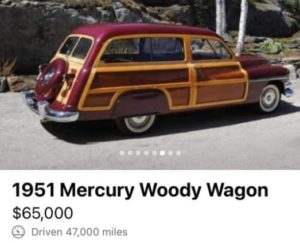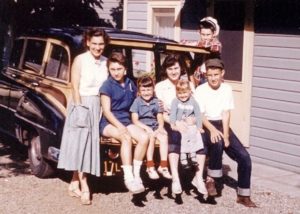
A Happy Hollisters fan recently shared this ad for a super-swell 1951 Mercury Woody Wagon—only 47,000 miles on her and for a paltry $65,000 she could be ours! Wouldn’t that be a swell vehicle for us? We’d love to load that baby up with our book inventory when we head out on The Happy Hollisters Classic Mystery Tour! Until we win the lottery, however, we’ll just have to use our powers of make-believe and settle for reading about the Hollister family’s adventures in their woody (sometimes spelled woodie). Mr. Hollister’s wood-paneled station wagon provided transportation for plenty of adventures around Shoreham and reading about those adventures can transport nostalgic readers back to the days when cars like this were all the rage.
In the early 20th century, when cars were becoming a more common sight on American roads, car frames were made of wood instead of the steel that modern manufacturers use. American consumers were gradually making the shift from horse-drawn carriages, previously the most common mode of transportation, and still saw wood-based transportation as classy, stylish, and symbolic of the upper class. The first mass-produced type was the Model A with a wood body, created by Ford in 1929. Other manufacturers followed suit, and woodies were made by other big-name car companies like Dodge and Chrysler.
 Woodies were often built like traditional station wagons, with a long body, plenty of passenger space, and an extra door in the rear. Their most unique feature, however, was that the back and sides were constructed of solid wood or panels of wood attached to a metal frame. By the 1940s, woodies had become a popular choice for many Americans. Large families, like the fictional Hollisters, loved them for their spacious storage and ability to fit the entire family comfortably. Andrew Svenson, who wrote The Happy Hollisters series under the pseudonym Jerry West, had a gorgeous blue woody in which he ferried his six children on many vacations, some of which inspired the Hollisters’ adventures.
Woodies were often built like traditional station wagons, with a long body, plenty of passenger space, and an extra door in the rear. Their most unique feature, however, was that the back and sides were constructed of solid wood or panels of wood attached to a metal frame. By the 1940s, woodies had become a popular choice for many Americans. Large families, like the fictional Hollisters, loved them for their spacious storage and ability to fit the entire family comfortably. Andrew Svenson, who wrote The Happy Hollisters series under the pseudonym Jerry West, had a gorgeous blue woody in which he ferried his six children on many vacations, some of which inspired the Hollisters’ adventures.
Woodies fell out of popularity by the late 1950s. They were expensive to produce and were much heavier than steel-framed cars, so gas consumption was becoming an issue. They also had other drawbacks, including a propensity for rotting, and many owners decided that the expensive maintenance and upkeep weren’t worth the unique look. With increasing production costs and decreasing demand, the last wood-body vehicle was made by Buick in 1953. However, they still remained a nostalgic symbol of an earlier time and experienced a brief comeback in the 1960s, when old woodies became a staple of surfer culture on the west coast.
Today, it’s very uncommon to spot a vintage woody on the road, but some collectors still proudly display their classic models at car shows. And of course, those seeking a bit of nostalgia can also find fond memories of the woody era in the pages a Happy Hollisters book.
By Libby Svenson Kennedy
Sources:
Research notes, Andrew Svenson Archives of The Hollister Family Properties Trust
http://www.classic-car-history.com/woodie-wagons.htm
https://www.hotcars.com/reason-people-buy-woodies/

